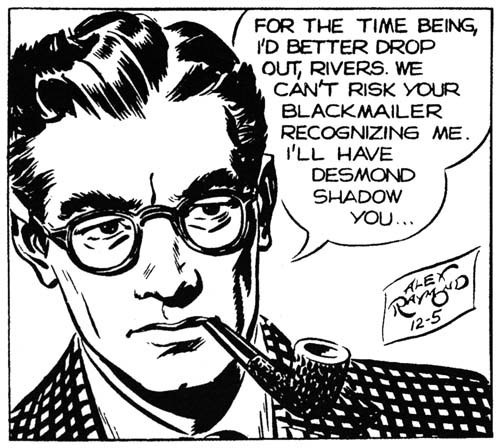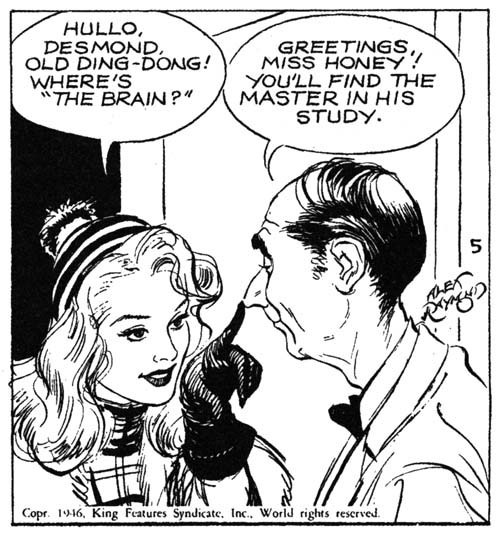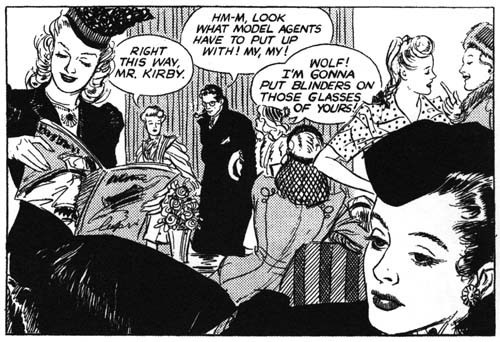"Mad Men" With Guns
 My pal the legendary Beau SmithTM was good enough to send me a copy of the Library of American Comics' first volume of Rip Kirby: The First Modern Detective. Let me tell you, it is gorgeous. A beautifully designed collection of newspaper comic strips –
My pal the legendary Beau SmithTM was good enough to send me a copy of the Library of American Comics' first volume of Rip Kirby: The First Modern Detective. Let me tell you, it is gorgeous. A beautifully designed collection of newspaper comic strips –
I see. Some of you are looking at your screens in confusion. I'll back up.
Way back when, there were these things called newspapers, and in these collections of cheap folded paper, among reports of yesterday's news, sports scores and horoscopes, were comic strips.
I'm not talking about most of the stuff that passes for "funny pages" in today's papers. If you've seen them, you'll know most of them are about as funny and relevant as one of Lee Abrams' memos to the Tribune Co. Some of them can be pretty great, true, but even the best are usually faint echoes of Calvin and Hobbes, Bloom County and The Far Side. Only Doonesbury remains intelligent and consistently funny.
Even before those strips, there were others that were capsule-sized doses of action and entertainment and black-and-white thrills. As a kid, I got only occasional glimpses of them, when I'd visit relatives in cities where the comics section was more than a half-page crammed onto the back of the lifestyles section. I'd spend a week or so with the grandparents, getting sucked in to stories despite myself, and then it was back on the plane, forever wondering what exactly happened in the next episode. Before TV embraced genre shows like "Lost," or even prime-time soap operas like "Dallas," comic strips were the place people could get their fix of serialized entertainment, with a cliffhanger every day.
One strip I was always curious about was Rip Kirby. It remained mostly unknown to me, until I began reading the strips from the beginning in the Library's hardcover collection. Now that I've gotten a glimpse into the golden age of Kirby's days in the daily papers, I'm sadder than ever it's gone. Because it's truly amazing stuff.
Kirby was a genuine intellectual, living in postwar New York. In between knocking out thick tomes on chemistry, he lived in a swank apartment with a butler, and took in plays and exclusive clubs with his (much younger) blonde girlfriend. He wore a tie and glasses and smoked a pipe. But anyone fooled by the college professor look was in for a world of hurt. Rip was an ex-Marine, and he could take a punch or a bullet as well as deliver them. There are spies and gangsters and scientists and femme fatales, and Kirby handles them all like a homegrown James Bond.
Written and drawn by Alex Raymond (who also created Flash Gordon) until his death, Rip Kirby is often surprisingly sophisticated in its plots, and it's cool to see where many of the tropes of later crime shows came from. ("CSI," whether the creators know it or not, owes a huge pile of gratitude to Rip and his methods of "scientific detecting.")
But for me, Rip Kirby is mainly compelling as a beautiful portrait of the beginning of America's transformation into the world's dominant force; essentially, Mad Men with guns. After World War II, literally millions of men returned home to find themselves in a country that was both triumphant and unsettled. They needed new ways of looking at themselves, new stories and new heroes to fill them. Rip Kirby delivered a two-fisted intellectualism, a guy who might be baffled at first, but who would eventually get all the answers. Reading his stories a half-century later, you can still see how much he influenced us, and all the ways we've tried to live up to his example, and too often, all the ways we've failed.
It's also a lot of fun. I mean, it is a comic strip, after all.













